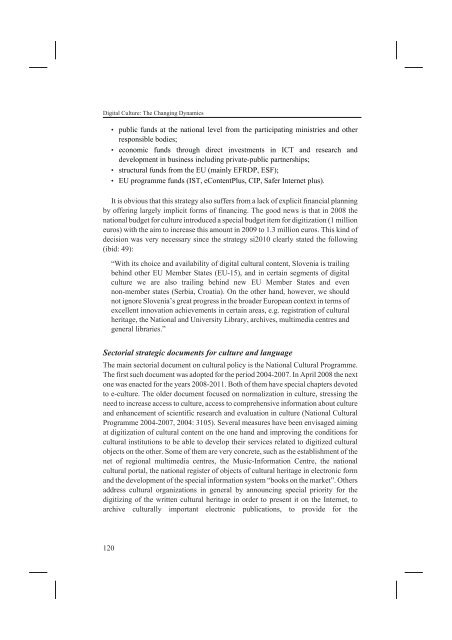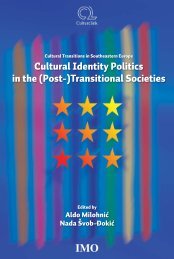D:\Documents and Settings\Ana\My Documents\Biserka-knjiga ...
D:\Documents and Settings\Ana\My Documents\Biserka-knjiga ...
D:\Documents and Settings\Ana\My Documents\Biserka-knjiga ...
Create successful ePaper yourself
Turn your PDF publications into a flip-book with our unique Google optimized e-Paper software.
Digital Culture: The Changing Dynamics<br />
• public funds at the national level from the participating ministries <strong>and</strong> other<br />
responsible bodies;<br />
• economic funds through direct investments in ICT <strong>and</strong> research <strong>and</strong><br />
development in business including private-public partnerships;<br />
• structural funds from the EU (mainly EFRDP, ESF);<br />
• EU programme funds (IST, eContentPlus, CIP, Safer Internet plus).<br />
It is obvious that this strategy also suffers from a lack of explicit financial planning<br />
by offering largely implicit forms of financing. The good news is that in 2008 the<br />
national budget for culture introduced a special budget item for digitization (1 million<br />
euros) with the aim to increase this amount in 2009 to 1.3 million euros. This kind of<br />
decision was very necessary since the strategy si2010 clearly stated the following<br />
(ibid: 49):<br />
“With its choice <strong>and</strong> availability of digital cultural content, Slovenia is trailing<br />
behind other EU Member States (EU-15), <strong>and</strong> in certain segments of digital<br />
culture we are also trailing behind new EU Member States <strong>and</strong> even<br />
non-member states (Serbia, Croatia). On the other h<strong>and</strong>, however, we should<br />
not ignore Slovenia’s great progress in the broader European context in terms of<br />
excellent innovation achievements in certain areas, e.g. registration of cultural<br />
heritage, the National <strong>and</strong> University Library, archives, multimedia centres <strong>and</strong><br />
general libraries.”<br />
Sectorial strategic documents for culture <strong>and</strong> language<br />
The main sectorial document on cultural policy is the National Cultural Programme.<br />
The first such document was adopted for the period 2004-2007. In April 2008 the next<br />
one was enacted for the years 2008-2011. Both of them have special chapters devoted<br />
to e-culture. The older document focused on normalization in culture, stressing the<br />
need to increase access to culture, access to comprehensive information about culture<br />
<strong>and</strong> enhancement of scientific research <strong>and</strong> evaluation in culture (National Cultural<br />
Programme 2004-2007, 2004: 3105). Several measures have been envisaged aiming<br />
at digitization of cultural content on the one h<strong>and</strong> <strong>and</strong> improving the conditions for<br />
cultural institutions to be able to develop their services related to digitized cultural<br />
objects on the other. Some of them are very concrete, such as the establishment of the<br />
net of regional multimedia centres, the Music-Information Centre, the national<br />
cultural portal, the national register of objects of cultural heritage in electronic form<br />
<strong>and</strong> the development of the special information system “books on the market”. Others<br />
address cultural organizations in general by announcing special priority for the<br />
digitizing of the written cultural heritage in order to present it on the Internet, to<br />
archive culturally important electronic publications, to provide for the<br />
120



